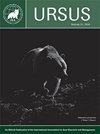雌性树懒熊发情时的气味标记行为
IF 0.6
4区 生物学
Q4 ZOOLOGY
引用次数: 1
摘要
摘要:树懒熊(Melursus ursinus)是被研究最少的熊类之一。树懒熊生物学和生态学的重要方面,如生殖生理学和行为,在很大程度上是未知的。其他种类的熊在繁殖季节通过摩擦肛门生殖器来增加气味标记。我们研究了在印度阿格拉熊救援中心圈养的37只雌性树懒熊(2-18岁)的生殖器摩擦行为,研究时间为3.5年(2015年6月1日至2018年12月31日)的4个繁殖季节。在整个研究期间,每天收集外阴可见性变化和生殖器摩擦行为的数据,其余时间每周收集两次。外阴可见度评分为0(不可见),1(略可见)和2(完全可见),如果外阴略可见或完全可见,则认为女性处于发情期。有生殖器摩擦记录为1,没有记录为0。生殖器摩擦的发生与发情相吻合,根据外阴可见性评分来定义。统计分析表明,女性年龄和身体接近(即在同一围栏内)的男性数量与生殖器摩擦行为的发生显著相关。物理接近的雌性数量和非物理接近的雌性数量(即不在同一个围栏内但共用一个围栏)对这种行为没有显著影响。我们的研究结果表明,雌性树懒熊在发情期的生殖器摩擦行为可能是一种气味标记,具有交流功能,并可能受到雄性存在的影响。这种行为可能是在野外繁殖季节吸引配偶的关键因素。本文章由计算机程序翻译,如有差异,请以英文原文为准。
Scent-marking behavior by female sloth bears during estrus
Abstract: The sloth bear (Melursus ursinus) is one of the least studied bears. Important aspects of sloth bear biology and ecology, such as reproductive physiology and behavior, are largely unknown. Increased scent-marking by anogenital rubbing during breeding season has been recorded in other bear species. We studied the genital rubbing behavior of 37 captive female sloth bears (2–18 yr of age) at the Agra Bear Rescue Facility, India, for 4 breeding seasons over a period of 3.5 years (1 Jun 2015 to 31 Dec 2018). Data on changes in vulva visibility and presence of genital rubbing behavior were collected daily during the breeding period and twice per week for rest of the year, throughout the study period. Vulva visibility was scored as 0 (not visible), 1 (slightly visible), and 2 (fully visible), and a female was considered to be in estrus if the vulva was slightly or fully visible. Presence of genital rubbing was recorded as 1 and its absence as 0. Occurrence of genital rubbing coincided with estrus, as defined by vulva visibility scores. Statistical analysis indicated that female age and the number of males with physical proximity (i.e., in the same enclosure) were significantly correlated with the occurrence of genital rubbing behavior. The number of females in physical proximity and the number of females in the vicinity without physical proximity (i.e., not in the same enclosure but sharing a fence) did not significantly affect this behavior. The results of our study suggest that the genital rubbing behavior by female sloth bears in estrus is likely a form of scent-marking, serving a communicative function, and could be influenced by male presence. This behavior may be a key factor in attracting a mate during the breeding season in the wild.
求助全文
通过发布文献求助,成功后即可免费获取论文全文。
去求助
来源期刊

Ursus
生物-动物学
CiteScore
2.00
自引率
15.40%
发文量
12
审稿时长
>12 weeks
期刊介绍:
Ursus includes a variety of articles on all aspects of bear management and research worldwide. Original manuscripts are welcome. In addition to manuscripts reporting original research, submissions may be based on thoughtful review and synthesis of previously-reported information, innovative philosophies and opinions, and public policy or legal aspects of wildlife conservation. Notes of general interest are also welcome. Invited manuscripts will be clearly identified, but will still be subject to peer review. All manuscripts must be in English. All manuscripts are peer-reviewed, and subject to rigorous editorial standards.
 求助内容:
求助内容: 应助结果提醒方式:
应助结果提醒方式:


